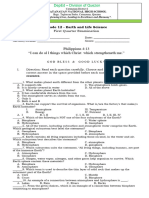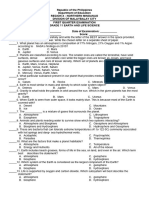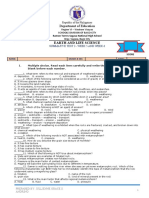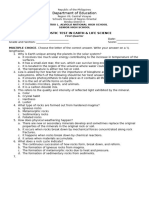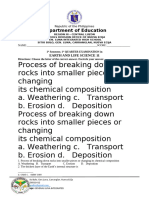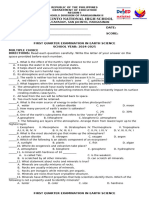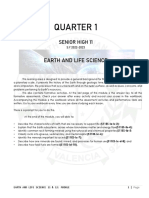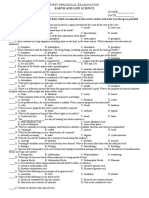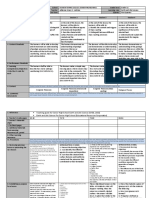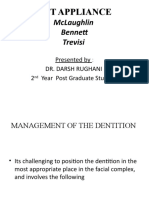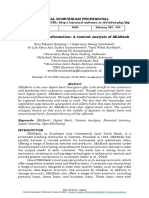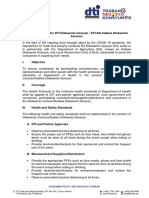ELSsum1 (20 21)
ELSsum1 (20 21)
Uploaded by
jullienneCopyright:
Available Formats
ELSsum1 (20 21)
ELSsum1 (20 21)
Uploaded by
jullienneOriginal Title
Copyright
Available Formats
Share this document
Did you find this document useful?
Is this content inappropriate?
Copyright:
Available Formats
ELSsum1 (20 21)
ELSsum1 (20 21)
Uploaded by
jullienneCopyright:
Available Formats
Republic of the Philippines
Department of Education
Region VI – Western Visayas
SCHOOLS DIVISION OF BAGO CITY
Ramon Torres Sagasa National High School
Brgy. Sagasa, Bago City
EARTH AND LIFE SCIENCE
SUMMATIVE TEST 1
WEEK 1 AND WEEK 2
SCORE
NAME: GRADE & SEC: DATE:
Multiple choice. Read each item carefully and write the correct answer on the blank before
each number.
______1. What makes planet Earth different from the other planets in the solar system?
A. It supports life. C. The atmosphere holds gases.
B. It is mostly covered in water. D. All of the above
______2. Earth can support the survival of organisms. What is/are the factor/s that make/s Earth habitable?
I. atmosphere III. temperature
II. energy IV. nutrient
A. I B. I, II C. I, II, III D. I, II, III, IV
______3. What is the reason why every living thing on Earth has the chance of survival?
A. Earth is covered with 65% water.
B. Earth thick atmosphere consisted mainly of carbon dioxide.
C. Earth has active volcanoes similar with those that are found in Venus.
D. Earth has ozone layer to protect living organisms from harmful radiation.
______4. Which is not true in a comparison between Mars and Earth?
A. It has life mechanism.
B. It has water and atmosphere.
C. It has carbon dioxide in the atmosphere.
D. It has atmosphere that supports oxygen.
______5. Earth includes beach grasses, forms of life in the sea, on land, and even in the air. Which term best
describes the statement?
A. atmosphere B. biosphere C. geosphere D. hydrosphere
______6. Which system of the Earth is considered as the largest component of the Earth?
A. atmosphere B. biosphere C. geosphere D. hydrosphere
______7. Relationship between the complex communities of individual organism is seen in the different systems
of the Earth. What do you call the unit in nature?
A. ecosystem B. complexity C. ground D. system
______8. What is an example of a connection between atmosphere and geosphere?
A. water B. nitrogen C. mountains D. volcanic eruption release gas
______9. The atmosphere of the Earth is composed of ___ oxygen and _____ nitrogen and other gases.
A. 0% and 100% C. 78% and 21%
B. 21% and 78% D. 50% and 50%
PREPARED BY: JULLIENNE GRACE S. ANDRINO 1
______10. Ozone plays an important function in every single organism on Earth. To what sphere does ozone
layer belong?
A. atmosphere B. biosphere C. geosphere D. hydrosphere
______11. Which property refers to the resistance of minerals to scratching?
A. Cleavage B. Fracture C. Hardness D. Luster
______12. What are the building blocks of rocks and it is mostly found in the
geosphere?
A. elements B. minerals C. ore D. soil
______13. In its powdered form, the mineral hematite is reddish. Which mineral
property is best described?
A. color B. hardness C. luster D. streak
______14. What refers to the tendency for a mineral to break along flat surfaces?
A. cleavage B. hardness C. ductility D. tenacity
______What is the solid form of a mineral produced by a repeating pattern of
atoms?
A. crystal B. density C. element D. fracture
______16. Quartz can break other than along planes of cleavage. What property
of minerals is shown in this situation?
A. Cleavage B. Fracture C. Hardness D. Streak
______17. Igneous rock is divided into two groups, extrusive and intrusive Extrusive igneous rocks form when
magma makes its way to its surface as lava and the cools forming rocks. Which will be the characteristics of the
crystals?
A. Crystals are very large.
B. Crystals are phaneritic.
C. Crystals are fine grained.
D. Crystals are coarse grained.
______18. What is the natural process that causes one kind of rock to change into another kind?
A. weathering B. rock cycle C. Sediments D. Metamorphism
______19. What is the type of rock formed from lava that cools quickly that results to
finer grain and smaller size of crystals?
A. Extrusive igneous rock C. Metamorphic rock
B Intrusive igneous rock D. Sedimentary rock
______20. Which of the following represents the correct order of the processes responsible for the formation of
sedimentary rocks?
A. Compaction, cementation, deposition, weathering, erosion
B. Deposition, cementation, compaction, erosion, weathering
C. Erosion, weathering, compaction, cementation, deposition
D. Weathering, erosion, deposition, compaction, cementation
______________________________ ______________________________
Teacher’s Name and Signature Parent’s Name and Signature
PREPARED BY: JULLIENNE GRACE S. ANDRINO 2
You might also like
- Long Quiz Earth and Life ScienceDocument2 pagesLong Quiz Earth and Life SciencePocholo Garcia100% (1)
- Earth and Life - TQDocument5 pagesEarth and Life - TQLouie Jane EleccionNo ratings yet
- First Quarter Exam ELSDocument6 pagesFirst Quarter Exam ELSAnalie LlorenteNo ratings yet
- Earth and Life Science ExamDocument4 pagesEarth and Life Science ExamNICOLE ANN GARINNo ratings yet
- Earth and Life ScienceDocument6 pagesEarth and Life ScienceMailene MagsicoNo ratings yet
- EARTH AND LIFE SCIENCE II Answer KeyDocument4 pagesEARTH AND LIFE SCIENCE II Answer Keyjelena jorgeoNo ratings yet
- Midterm Exam-Eals-2022-2023Document4 pagesMidterm Exam-Eals-2022-2023Ricky Boy AtilanoNo ratings yet
- G11EALDocument4 pagesG11EALfrancisjude.delacruzNo ratings yet
- Summative Test Week 1 - 4 Earth and Life ScienceDocument2 pagesSummative Test Week 1 - 4 Earth and Life ScienceCherrina AguilaNo ratings yet
- 1st Quarter Diagnostic Test in ELS 11Document3 pages1st Quarter Diagnostic Test in ELS 11ivyNo ratings yet
- ELSsum3 (20 21)Document2 pagesELSsum3 (20 21)jullienneNo ratings yet
- Summative TestDocument4 pagesSummative TestJaysonEscatronPaguilaNo ratings yet
- Quiz Number 1Document1 pageQuiz Number 1joann.magallonesNo ratings yet
- Earth and Life ScienceDocument6 pagesEarth and Life ScienceMyriel Jean LuigNo ratings yet
- 2nd QUARTER EXAM FINALDocument3 pages2nd QUARTER EXAM FINALjuliusvaldez07201996No ratings yet
- Earth and Life Science DIAGNOSTIC TestDocument4 pagesEarth and Life Science DIAGNOSTIC TestSheena MovillaNo ratings yet
- Notre Dame of Tacurong College Earth and Life ScienceDocument4 pagesNotre Dame of Tacurong College Earth and Life Scienceargenius23No ratings yet
- Notre Dame of Tacurong College Earth and Life ScienceDocument4 pagesNotre Dame of Tacurong College Earth and Life Scienceargenius23No ratings yet
- Earth and Life ScienceDocument3 pagesEarth and Life ScienceKemberly MatulacNo ratings yet
- Earth and Life Science With Answer KeyDocument5 pagesEarth and Life Science With Answer KeyEmerson GalanoNo ratings yet
- Earth and Life Pre TestDocument6 pagesEarth and Life Pre Testjul kimNo ratings yet
- 1st QE EARTH SCIENCEDocument3 pages1st QE EARTH SCIENCEjuliusvaldez07201996No ratings yet
- Scie PT Q4Document7 pagesScie PT Q4Super JNo ratings yet
- Earth and Life ScienceDocument4 pagesEarth and Life SciencerhoszielbNo ratings yet
- EARTH AND LIFE SCIENCE SUMMATIVE EXAMDocument4 pagesEARTH AND LIFE SCIENCE SUMMATIVE EXAMZayda ZiramaNo ratings yet
- FINAL Diagnostic Test in Earth & Life ScienceDocument1 pageFINAL Diagnostic Test in Earth & Life ScienceBlossom Mae TorresNo ratings yet
- 1st QuarterDocument5 pages1st QuarterlindyNo ratings yet
- earth and life science quarter examDocument3 pagesearth and life science quarter examRo ZenNo ratings yet
- Pre-Test-In-Earth-And-Life-Science-Answer-Keydocx DIAGNOSTIC TESTDocument3 pagesPre-Test-In-Earth-And-Life-Science-Answer-Keydocx DIAGNOSTIC TESTMiko ManteNo ratings yet
- First Quarter Examination: Judge Edmundo Pinga National High SchoolDocument4 pagesFirst Quarter Examination: Judge Edmundo Pinga National High SchoolMikee MercadoNo ratings yet
- First Quarter Exam PSDocument6 pagesFirst Quarter Exam PSAnalie LlorenteNo ratings yet
- Earth and Life Sciences Remediation q1Document9 pagesEarth and Life Sciences Remediation q1Rylyn Joy Almojallas MagsayoNo ratings yet
- Exam MIDTERM 1Document5 pagesExam MIDTERM 1CheckayNo ratings yet
- 1st QUARTER EXAM IN EARTH SCIENCEDocument5 pages1st QUARTER EXAM IN EARTH SCIENCENorman James CuyoNo ratings yet
- Summative Test Earth and Life Science Module 1: NAME: - GRADE & SECTIONDocument8 pagesSummative Test Earth and Life Science Module 1: NAME: - GRADE & SECTIONMira Lei MarigmenNo ratings yet
- PT - Science 5 - Q4Document7 pagesPT - Science 5 - Q4archietrinidad78No ratings yet
- Earth and Life Science 1ST GradingDocument8 pagesEarth and Life Science 1ST Gradingyapkiko01No ratings yet
- Midterm - Earth ScienceDocument4 pagesMidterm - Earth ScienceNini VillezaNo ratings yet
- SDO Navotas EarthLifeScience SHS 1st2ndsem - FVDocument100 pagesSDO Navotas EarthLifeScience SHS 1st2ndsem - FVdoyoung of treasure is the only doyoung everNo ratings yet
- achievement test inI ELS-1st qDocument7 pagesachievement test inI ELS-1st qcristina maquintoNo ratings yet
- 2021 Summative Test ELSDocument5 pages2021 Summative Test ELSKristian Jay NantaNo ratings yet
- Earth Science Module 1 Final Edited Grade 11Document22 pagesEarth Science Module 1 Final Edited Grade 11Nicole Mae SumaltaNo ratings yet
- PT Earth and Life Science Q1Document5 pagesPT Earth and Life Science Q1Mika Jade BaddalNo ratings yet
- 1st Monthly Exam (Earth and Life Science 11)Document3 pages1st Monthly Exam (Earth and Life Science 11)Ricar MonforteNo ratings yet
- Earth and Life Science Q1 TQDocument11 pagesEarth and Life Science Q1 TQcagatmaleizerjoyNo ratings yet
- Test Questionnaire IN ELS (1)Document6 pagesTest Questionnaire IN ELS (1)cristina maquintoNo ratings yet
- QUIZ#1Document3 pagesQUIZ#1Princess DeramasNo ratings yet
- ST 1Document2 pagesST 1JESSA SUMAYANGNo ratings yet
- Long TestDocument1 pageLong TestharukincaidNo ratings yet
- EALS 1st Quarter Examination-New FormatDocument4 pagesEALS 1st Quarter Examination-New FormatMehca Ali SacayanNo ratings yet
- 1STQT Exam-Earth&lifeDocument2 pages1STQT Exam-Earth&lifeROXANNE APOSTOLNo ratings yet
- Reviewer For Earth and Life ScienceDocument7 pagesReviewer For Earth and Life ScienceCharis LacordaNo ratings yet
- Earth and Life Science Exam TQDocument4 pagesEarth and Life Science Exam TQBless MendozaNo ratings yet
- Name: - Score: - Grade & Section: - DateDocument4 pagesName: - Score: - Grade & Section: - DateMichelle Ramirez Co-Gonzales100% (1)
- 1st Quarterly Examination-Earth-and-Life-Science-2022-2023Document7 pages1st Quarterly Examination-Earth-and-Life-Science-2022-2023Maryjul Ramos Ranay100% (4)
- Earth & Life Science Summative TestDocument2 pagesEarth & Life Science Summative TestAriane Ignao Lagatic50% (2)
- Science 5 - 4th Quarter TestDocument4 pagesScience 5 - 4th Quarter Testreynalyn suangcoNo ratings yet
- Pretest Earth and Life Sy 22-23Document25 pagesPretest Earth and Life Sy 22-23Morena AbayonNo ratings yet
- DIAGNOSTIC TEST IN EARTH AND LIFE SCIENCE -school basedDocument7 pagesDIAGNOSTIC TEST IN EARTH AND LIFE SCIENCE -school basedcristina maquintoNo ratings yet
- Quarterly Assessment - Physcial ScienceDocument6 pagesQuarterly Assessment - Physcial SciencejullienneNo ratings yet
- Physical Sci Sum 3Document3 pagesPhysical Sci Sum 3jullienneNo ratings yet
- DLL 2Document5 pagesDLL 2jullienneNo ratings yet
- ELSsum3 (20 21)Document2 pagesELSsum3 (20 21)jullienneNo ratings yet
- DLL 1Document4 pagesDLL 1jullienneNo ratings yet
- DLL 3Document6 pagesDLL 3jullienneNo ratings yet
- DLL 5Document5 pagesDLL 5jullienneNo ratings yet
- DLL 4Document4 pagesDLL 4jullienneNo ratings yet
- ICT Model Paper 1Document12 pagesICT Model Paper 1FathimaNo ratings yet
- JAdhesDent2011 Kern SasseDocument4 pagesJAdhesDent2011 Kern SasseMariana CordeiroNo ratings yet
- Web-Site: WWW - Hafed.gov - In: TEL: 2590520-24, FAX: 2590711 E Mail: Hafed@hry - Nic.inDocument11 pagesWeb-Site: WWW - Hafed.gov - In: TEL: 2590520-24, FAX: 2590711 E Mail: Hafed@hry - Nic.inshashikant gaurNo ratings yet
- Global Package Tracking - AfterShipDocument1 pageGlobal Package Tracking - AfterShipednevz007No ratings yet
- MBT Appliance: Mclaughlin Bennett TrevisiDocument247 pagesMBT Appliance: Mclaughlin Bennett TrevisiJustFine DolittleNo ratings yet
- DLL For COT IN MAPEH 7 2nd QTRDocument4 pagesDLL For COT IN MAPEH 7 2nd QTRMA Cecilia CuatrizNo ratings yet
- CWKARLDocument9 pagesCWKARLKarlo D. ReclaNo ratings yet
- Mobile Computing and Wireless Communications - Short Tutorial and R&D TrendsDocument36 pagesMobile Computing and Wireless Communications - Short Tutorial and R&D TrendskanjankanjanNo ratings yet
- 2 3 Dividing Mixed Numbers MixedDocument2 pages2 3 Dividing Mixed Numbers Mixedapi-307130627No ratings yet
- Bios ch3Document23 pagesBios ch3Tech R&BNo ratings yet
- A Content Analysis of SeabankDocument13 pagesA Content Analysis of SeabankMarielet Dela PazNo ratings yet
- MMTC Franchisee ApplnDocument3 pagesMMTC Franchisee ApplnrajatmaheshwariNo ratings yet
- Welding Wire and TIG Rods Type TD-S2Document4 pagesWelding Wire and TIG Rods Type TD-S2Ferry PrasetiaNo ratings yet
- Bustion Equipments and Firing Methods For FuelsDocument62 pagesBustion Equipments and Firing Methods For FuelsTarvesh KumarNo ratings yet
- Health Protocol - Diskwento Caravan - As of Oct 22, 2020Document2 pagesHealth Protocol - Diskwento Caravan - As of Oct 22, 2020Randell ManjarresNo ratings yet
- 1831 73 4303 1 10 20220907Document12 pages1831 73 4303 1 10 20220907Jordan KopongNo ratings yet
- 65232en Beta Series Descr PDFDocument192 pages65232en Beta Series Descr PDFgmludNo ratings yet
- Y. B. Patil Polytechnic Akurdi, Pune: - Introduction To AutomobilesDocument15 pagesY. B. Patil Polytechnic Akurdi, Pune: - Introduction To AutomobilesNilesh PatilNo ratings yet
- CompSci A Course DescriptionDocument83 pagesCompSci A Course DescriptionAngelaNo ratings yet
- Catalog PLC GuideDocument38 pagesCatalog PLC GuideOsama MohammedNo ratings yet
- Kenya: Mavoko Urban ProfileDocument33 pagesKenya: Mavoko Urban ProfileUnited Nations Human Settlements Programme (UN-HABITAT)No ratings yet
- Wu 2016Document7 pagesWu 2016Gaurav SushrutNo ratings yet
- Environmental Law Module 2Document17 pagesEnvironmental Law Module 2Arya RajNo ratings yet
- Introduction To Molecular Biology: Salwa Hassan Teama M.DDocument59 pagesIntroduction To Molecular Biology: Salwa Hassan Teama M.Dahmed fouadNo ratings yet
- Modified Semilunar Coronally Advanced Flap: A Case SeriesDocument4 pagesModified Semilunar Coronally Advanced Flap: A Case SeriesrindaNo ratings yet
- Instruction Manual Serial Number:: Version 1.4 Uk Original Language "English"Document36 pagesInstruction Manual Serial Number:: Version 1.4 Uk Original Language "English"Jose Gabriel Aguirre AndradeNo ratings yet
- Print Article - PatentabilityDocument9 pagesPrint Article - PatentabilityDhaval Gohel100% (1)
- Anthony Lellouche: Work Experience SkillsDocument1 pageAnthony Lellouche: Work Experience Skillsadmin StilyoAppsNo ratings yet
- Coursera Enterprise Catalogue - MasterDocument392 pagesCoursera Enterprise Catalogue - MasterSaurabh RajNo ratings yet
- Communication System Lecture Notes PDFDocument2 pagesCommunication System Lecture Notes PDFJason50% (2)



